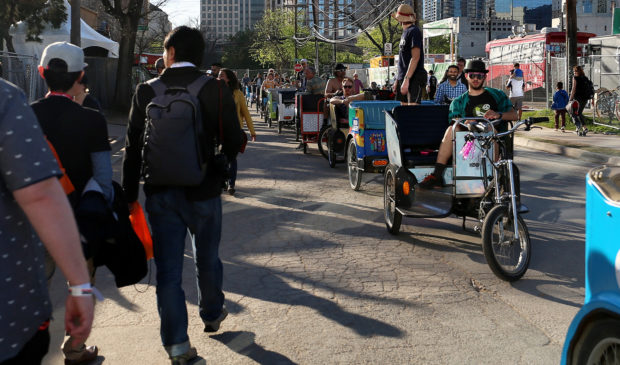Report finds most traffic on Rainey Street stems from surrounding roadways
Monday, June 5, 2017 by
Syeda Hasan Traffic congestion has long been a concern for people who live and work along Rainey Street. Last year, neighbors struck a deal with a developer looking to build new condos in the area. They agreed to conduct a comprehensive traffic study to identify transportation needs and guide future development.
The Austin-based Sutton Company is expected to develop about 1.1 million square feet of commercial and residential space at the current site of the Villas on Town Lake condominiums. Lora Herring lived at the Villas for 23 years and still lives in the neighborhood. She said traffic on Rainey Street is manageable during weekdays, but not on nights and weekends.
“I don’t go out anymore, and I don’t try and go out at night on the weekends,” Herring said. “It’s just like, no, I’m not getting out in that.”
In fact, more than half of residents surveyed for the study reported taking two or fewer car trips a day. The study area is bounded by East Cesar Chavez Street, I-35, Lady Bird Lake and Waller Creek. It finds that 65 to 70 percent of the traffic on Rainey comes from the neighboring Red River or River streets. Another factor that adds to the congestion is the lack of designated drop-off points on Rainey. That leads vehicles to stop in the middle of the road. Herring said that’s an issue even outside of peak traffic times.
“With beer delivery trucks and stuff in the afternoon when it’s not busy, there’s still everybody, big old trucks, blocking the road,” she said.
Dan Hennessey is with Big Red Dog Engineering, which conducted the study. He said there’s not much that can be done to solve congestion on Rainey without addressing it on surrounding streets. The study found that peak congestion in the area stems from traffic on East Cesar Chavez Street and I-35.
“And, in fact, solving congestion along Cesar Chavez and 35 might actually increase volume within the neighborhood as more vehicles are able to get off those congested facilities and into Rainey Street and into those buildings,” Hennessey said.
Beyond traffic calming, the report also calls for increasing multimodal options, adding sidewalks, bike lanes and formal bus stops along Cesar Chavez Street. Hennessey said this research process has been a departure from the often-contentious discussions between neighbors and developers.
“It’s kind of a strange planning process for a neighborhood group to discuss with a developer and be allowed to do their own planning study,” he said. “It was a very unique process that gave us the ability to reach out to a lot of stakeholders and build consensus for what mobility in this neighborhood looks like going forward.”
The study identifies several potential developments on the horizon for the neighborhood. It estimates that they could increase transportation demand volumes by three or four times.
Download (PDF, 25.4MB)
This story was produced as part of the Austin Monitor’s reporting partnership with KUT. Photo by Stephanie Tacy for KUT News.
The Austin Monitor’s work is made possible by donations from the community. Though our reporting covers donors from time to time, we are careful to keep business and editorial efforts separate while maintaining transparency. A complete list of donors is available here, and our code of ethics is explained here.
You're a community leader
And we’re honored you look to us for serious, in-depth news. You know a strong community needs local and dedicated watchdog reporting. We’re here for you and that won’t change. Now will you take the powerful next step and support our nonprofit news organization?



